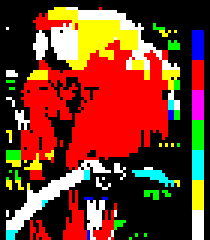|
Mullard SAA5050
The Mullard SAA5050 was a character generator chip for implementing the Teletext character set. The SAA5050 was used in teletext-equipped television sets, viewdata terminals, and microcomputers, most notably on computers like the Philips P2000 (1980), Acorn System 2 (1980), BBC Micro (1982), Malzak and the Poly-1. This chip was also manufactured by Mullard for Philips. Operation The chip generated appropriate video output for a 7-bit input character code representing the current character on the text line, while keeping track of the effect of any of the various control characters defined by the teletext standard that had previously occurred in that text line, which could be used to change the foreground and background colour, switch to or from the alternate block graphics character set, or various other effects. Full-screen resolution generated by the SAA5050 was 480×500 pixels, corresponding to 40×25 characters. Each character position therefore corresponded to a 12×20 ... [...More Info...] [...Related Items...] OR: [Wikipedia] [Google] [Baidu] |
Mullard SAA5050
The Mullard SAA5050 was a character generator chip for implementing the Teletext character set. The SAA5050 was used in teletext-equipped television sets, viewdata terminals, and microcomputers, most notably on computers like the Philips P2000 (1980), Acorn System 2 (1980), BBC Micro (1982), Malzak and the Poly-1. This chip was also manufactured by Mullard for Philips. Operation The chip generated appropriate video output for a 7-bit input character code representing the current character on the text line, while keeping track of the effect of any of the various control characters defined by the teletext standard that had previously occurred in that text line, which could be used to change the foreground and background colour, switch to or from the alternate block graphics character set, or various other effects. Full-screen resolution generated by the SAA5050 was 480×500 pixels, corresponding to 40×25 characters. Each character position therefore corresponded to a 12×20 ... [...More Info...] [...Related Items...] OR: [Wikipedia] [Google] [Baidu] |
Signetics
Signetics Corporation was an American electronics manufacturer specifically established to make integrated circuits. Founded in 1961, they went on to develop a number of early microprocessors and support chips, as well as the widely used 555 timer chip. The company was bought by Philips in 1975 and incorporated in Philips Semiconductors (now NXP). History Signetics was started in 1961, by a group of engineers (David Allison, David James, Lionel Kattner, and Mark Weissenstern) who had left Fairchild Semiconductor. At the time, Fairchild was concentrating on its discrete component business (mostly transistors), and its management felt that by making integrated circuits (ICs) it would lose its customers. Signetics founders believed that ICs were the future of electronics (much like another contemporary Fairchild spinoff, Amelco) and wished to commercialize them. The name of the new company was coined from Signal Network Electronics. The venture was financed by a group organized t ... [...More Info...] [...Related Items...] OR: [Wikipedia] [Google] [Baidu] |

